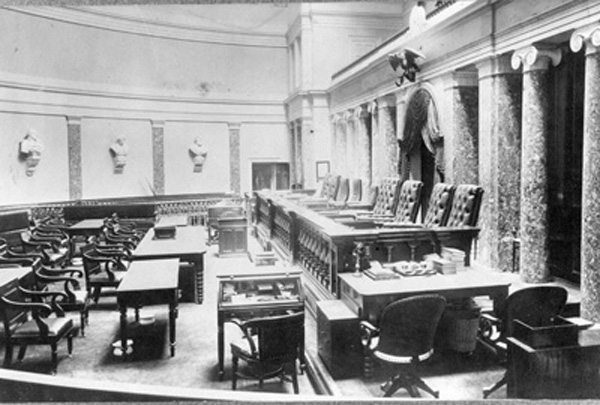Landmark Libel Cases :
 This is the Old Senate Chamber, where the U.S. Supreme Court sat from 1860-1935. In the 20th Century especially, the Supreme Court was the battleground for libel cases (U.S. Supreme Court).
This is the Old Senate Chamber, where the U.S. Supreme Court sat from 1860-1935. In the 20th Century especially, the Supreme Court was the battleground for libel cases (U.S. Supreme Court).
The cases described below are cases that shaped how libel is viewed in the United States over the past 100 years. The online court documents are provided by FindLaw.com, except for the last case link, which is provided by the law firm of Steptoe and Johnson. The links should open up in a new window.
Case Law Links:
These are the seminal cases in libel law, organized in order of
New York Times Co. v. Sullivan (1964)-- This is the case that established the so-called "New York Times actual malice" standard in the United States. In the opening volleys of the civil rights movement, The New York Times published an advertisement that described oppressive conditions in Montgomery, Ala. It contained some false statements, most of which were incidental. The Montgomery police commissioner at the time, L.B. Sullivan, sued for libel, demanding a retraction on the grounds that it damaged his reputation as a police official. The item above links to the Supreme Court's decision, which in a nutshell noted that to protect healthy public debate under the First Amendment, a public official had to prove that defamatory language was, in the words of Middleton and Lee, "published with knowing falsity or reckless disregard for the truth."
Harte-Hanks Communications v. Connaughton (1989)-- This case refined the actual malice standard. Daniel Connaughton, a candidate for an Ohio judgeship had some members of his office investigated by a grand jury. One of the witnesses testifying in the case offered a quote to the Journal-News referring to "dirty tricks" that Connaughton allegedly practiced. He sued the newspaper and won. The Supreme Court determined that the newspaper did not pursue the truth with due diligence. It's worth going over what the Supreme Court determined was "actual malice."
According to the Court:
1. The paper relied on a questionable source.
2. It did not seek out other, more reliable sources.
3. It ignored taped evidence to the contrary.
4. It ignored Connaughton's statements to the contrary.
5. It ignored the probability of questionable facts.
6. It published an editorial that seemed to indicate prejudice, as it contained opinions that were harbingers of conclusions reached in the news article.
7. The newspaper's management and its reporters gave differing accounts of assignments concerning the story.
Gertz v. Robert Welch, Inc. (1974)-- This is the case in which the Supreme Court delineated the burdens of proof between public and private individuals and the applicability of actual malice so far as defamation law is concerned. Elmer Gertz, an attorney, was labeled as a "Leninist" by a publication in Chicago. After suing the publication, the magazine attempted to fall back on the argument that the actual malice standard protected their characterization of his political beliefs because the lawyer was a public figure. The Supreme Court disagreed. This is the reason why libel plaintiffs always like to say they're private citizens -- thanks to the standards of actual malice and private citizens created by Times v. Sullivan and Gertz v. Welch, there is a far lower burden of proof for private figures vs. public figures.
Milkovich v. Lorain Journal Co. (1990)-- This case essentially put publications on notice that just because someone is expressing an opinion, that doesn't mean they're words are libel-proof. In this case a wrestling coach's team was involved in a fight during a match that became the subject of a criminal investigation. A columnist for the News-Herald in Ohio stated in an opinion piece that the coach was a liar -- which the Court determined implied that he had committed the act of perjury. The Court ruled that Milkovich had a right to sue under Ohio's libel laws and he settled out of court. This is the reason why columnists use hyperbole, nuance and figures of speech -- those writing conventions are less libel-prone.
Recent Cases of Interest:
Kaelin v. Globe Communications Corp. (1998)
Zeran v. America Online (1997)
Grace v. eBay Inc. (2004)
Other Useful Links:
Here is the Oyez Project's guide to Supreme Court cases involving the libel concepts of both defamation and invasion of privacy.
For general law resources, the Cornell University law school has a useful site with a wealth of resources here.






